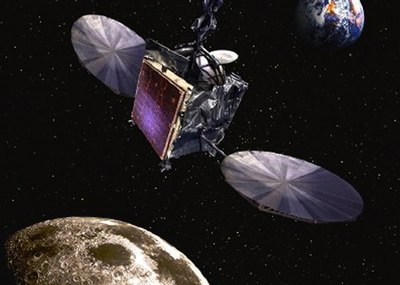An alternative view of the HGS-1 salvage missionby Mark Skidmore
|
| At no time during any of our many meetings did Salvatore ever mention Ridenoure or IOD, or indicate that they or anyone else had suggested to him to use the Moon’s gravity to reposition AsiaSat 3. |
AsiaSat 3, a Hughes HS 601 HP satellite, was launched on Christmas Day, 1997. The fourth stage of the Russian Proton booster malfunctioned, operating for only two seconds out of a planned 110-second burn. This left AsiaSat 3 stranded in a useless, highly inclined orbit. Upon returning from the holiday shutdown in January 1998, I was assigned the task of examining options to salvage AsiaSat 3. At that time I was a director at Hughes Global Services (“HGS”.) I would later become HGS’ program manager for the recovery mission.
Throughout January and into early February, I met regularly with Jerry Salvatore, Hughes Space and Communications Chief Technologist, who was exploring ways to maneuver the AsiaSat 3 satellite into an economically viable orbit, including inclined synchronous and non-synchronous orbits. At no time during any of our many meetings did Salvatore ever mention Ridenoure or IOD, or indicate that they or anyone else had suggested to him to use the Moon’s gravity to reposition AsiaSat 3.
The latter did not come up until a chance meeting between Salvatore and Ronald Swanson, president of HGS, in a Hughes parking lot. Swanson mentioned the Moon, and in a stroke of genius, Salvatore realized that a lunar flyby could be used to reposition the satellite, known as HGS-1 after HGS acquired it from the insurance underwriters, into a commercially attractive orbit. Salvatore’s concept was like the “free return” trajectory employed by Apollo 13. Salvatore was subsequently awarded two US patents for his innovation. Those patents have never been challenged.
Hughes engineer Cesar Ocampo is mentioned frequently in Ridenoure’s article and has published his own personal views on the mission. The insinuation that Hughes conspired to suppress Ridenoure and IOD’s self-proclaimed contributions by prohibiting Ocampo (and others) from communicating with the media is simply not true. Hughes’ policy was that only designated employees were authorized to represent the company to the media. This policy existed long before the HGS-1 mission. As the program manager, I was designated as a media contact. Mark Schwene, vice president of business development at HGS, and Hughes’ senior executives were also authorized to speak with the media. It was a very small group. Not even Salvatore, the veteran mission manager, was authorized to engage the media during the course of the mission. As a lower level engineer focusing on a narrowly defined, highly technical aspect of the mission, Ocampo was simply not in a position to represent Hughes to the media. Ocampo disagreed and made his views known on many occasions.
Ridenoure freely admits that it was not possible for Hughes to either command or receive telemetry from HGS-1 at the distances from Earth necessitated by IOD’s approach. When Ridenoure and IOD learned of this fatal flaw in their concept, their tactics changed from attempting to convince Hughes to employ their intricate orbital techniques to claiming that they had inspired Salvatore to use the Moon’s gravity for a rescue mission. Nothing could be further from the truth. Salvatore had already conceived his elegantly simple approach by the time he, or I, were made aware of IOD’s concepts.
| From Salvatore and Swanson’s “ah-ha” moment in the parking lot through to the final retro burn positioning HGS-1 in geosynchronous orbit, the HGS-1 recovery mission was an amazing team effort. |
Ridenoure and IOD mounted a remarkably effective campaign to convince the media that they were the genesis of Salvatore’s mission design. Their “little company gets squashed by big company” story angle played well. They pursued their campaign across multiple fronts, sometimes enlisting others to covertly press their case. In what can be only described as an ambush, the wife of an IOD associate peppered Salvatore and me with questions regarding the inspiration for the mission at a technical lecture we were giving at JPL. At no time did she disclose her relationship with the IOD group; we learned of this later. Hughes’ proper refusal to engage in a public tit-for-tat exchange with Ridenoure and IOD likely aided them in their public relations crusade.
Ridenoure and IOD’s continued insistence that they were the catalyst for Hughes’ recovery mission was viewed by many within Hughes as a precursor to litigation. This proved to be true. IOD filed suit against Hughes. Although an extremely significant point, Ridenoure relegates the litigation to a footnote in his article. The court found that IOD’s claims were without merit and dismissed the suit by summary judgment. The court did not allow the case to proceed to trial. Furthermore, the court ordered that IOD pay Hughes for certain of Hughes’ costs of defense.
From Salvatore and Swanson’s “ah-ha” moment in the parking lot through to the final retro burn positioning HGS-1 in geosynchronous orbit, the HGS-1 recovery mission was an amazing team effort. For many of us it was a once-in-a-career opportunity. Hughes, PanAmSat, various specialist consultants, P.T. Satelindo, the US Space Command (now US Strategic Command), the US Air Force Space Command, MIT Lincoln Laboratories, Analytical Graphics, and others contributed to the success of the mission. Their efforts were publicly recognized by Hughes. Hughes willingly gave credit when credit was due. IOD and its affiliates did nothing but complain, badger, and unsuccessfully litigate. No amount of creative writing on their part will change the fact that they in no way influenced the HGS-1 recovery mission design or were involved in any way with its execution. The Hughes team, on the other hand, conceived, planned, and flawlessly executed this first commercial lunar mission. Such was the hallmark of Hughes.
